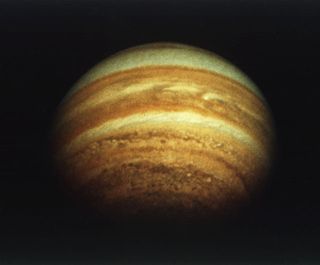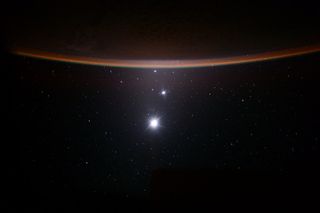Amateur astronomer discovers a tiny moon around Jupiter
This is the first time an amateur astronomer has discovered a moon around Jupiter.

An amater astronomer has discovered a previously unknown moon around Jupiter after poring over old telescope images, a major first.
"I’m proud to say that this is the first planetary moon discovered by an amateur astronomer!" moon searcher Kai Ly said in a July 8 Sky and Telescope report that details the discovery.
Jupiter may have dozens or even hundreds of undiscovered moons orbiting around it. This massive planet boasts a substantial gravitational field that allows it to capture space debris into its orbit. Jupiter currently hosts at least 79 moons, and the number continues to grow. The latest discovery was made by Ly, an amateur astronomer, and it's the latest addition to the catalogue of the Carme group of Jovian satellites.
Carme and its crew are small, odd-shaped space rocks. They orbit in the opposite direction of Jupiter's rotation — a phenomenon called retrograde — and the group travels around Jupiter at an extreme tilt relative to the giant planet's orbital plane, according to NASA. Carme is the largest of the group, with a mean radius of 14 miles (23 kilometers). Carme is the parent rock to the amateur astronomer's discovery and to the other 22 known members of the group. Astronomers think that Carme was an asteroid captured by Jupiter's gravity, and that its group are the bits that broke off of it following a cosmic collision.
Related: A lander on Jupiter's icy moon Europa may have to dig at least 1 foot down to find signs of life

Ly made their finding when looking online at a data set from 2003 that had been collected by researchers at the University of Hawai'i using the 3.6-meter Canada-France-Hawaii Telescope (CFHT). Ly paid special attention to the imagery collected in February of that year, when the moons were at their apparent brightest. This was caused by a phenomenon known as opposition, when the sun and a given planet appear in opposite parts of Earth's sky. Our home planet was sitting in the middle of a line between the sun and Jupiter in February 2003, allowing astronomers on Earth to clearly see Jupiter's system illuminated by the star.
Ly used observations from another telescope called Subaru to establish the object's 22-day arc, which showed the moon candidate was likely bound to Jupiter's gravity. This baseline allowed them to find and confirm the moon's existence with other datasets, too.
Get the Space.com Newsletter
Breaking space news, the latest updates on rocket launches, skywatching events and more!
In the Space and Telescope article, Ly described the exciting discovery as "a summer hobby before I return to school."
This rock is currently designated EJc0061, but does not yet have a formal name. When it does, it will likely end with the letter e like Carme. When NASA officials explained Carme's moniker, they said "a name ending in 'e' was chosen in accordance with the International Astronomical Union's policy for designating outer moons with retrograde orbits."
Follow Doris Elin Urrutia on Twitter @salazar_elin. Follow us on Twitter @Spacedotcom and on Facebook.
Join our Space Forums to keep talking space on the latest missions, night sky and more! And if you have a news tip, correction or comment, let us know at: community@space.com.

Doris is a science journalist and Space.com contributor. She received a B.A. in Sociology and Communications at Fordham University in New York City. Her first work was published in collaboration with London Mining Network, where her love of science writing was born. Her passion for astronomy started as a kid when she helped her sister build a model solar system in the Bronx. She got her first shot at astronomy writing as a Space.com editorial intern and continues to write about all things cosmic for the website. Doris has also written about microscopic plant life for Scientific American’s website and about whale calls for their print magazine. She has also written about ancient humans for Inverse, with stories ranging from how to recreate Pompeii’s cuisine to how to map the Polynesian expansion through genomics. She currently shares her home with two rabbits. Follow her on twitter at @salazar_elin.
